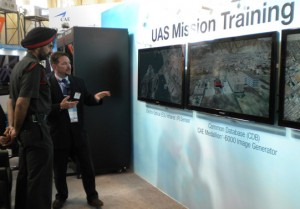CAE recently demonstrated its UAS mission training solutions at the biennial Aero India show in Bangalore. India’s Army, Navy and Air Force are all expected to significantly increase their use of unmanned aerial systems, and the three services are currently conducting trials to evaluate potential UAS training systems.
CAE is focusing on bringing a new level of virtual mission training capabilities to the unmanned aerial system (UAS) sector. By combining its simulation experience and technologies in areas such as sensor simulation, weapons effects, computer-generated forces, artificial intelligence, common databases and high-fidelity modeling, CAE believes the UAS market is ripe for a more comprehensive UAS mission training solution.
“Our aim is simple – to allow the entire UAS mission crew to conduct virtual mission training that is consistent with what they will likely see on the battlefield,” explains Adolfo Klassen, CAE’s Chief Technology Officer. “To do this, militaries need a much greater level of integration and interoperability with their UAS training systems.”
Current methods of UAS training typically consist of procedural training modes built into the original equipment manufacturers (OEM) ground control stations (GCS) or utilizing the actual UAS platform for training opportunities. These training approaches, while sufficient for familiarization or procedures, can be limited in scope and capability when it comes to mission training. In addition, they utilize limited and valuable UAS platform resources that could be used for operational tasking. Today’s UAS crews have performed remarkably well, but their mission training has taken place primarily during actual operations on the battlefield.
“Having trained as a fighter pilot, I have had a lot of combat time with close air support missions,” said Keven Gambold, a former Royal Air Force Tornado pilot turned Predator/Reaper operator, and now Operations Director for Unmanned Experts. “When transitioning to operate UAS, it was more of a conversion course. We weren’t trained very well for the missions we had to operate, but we knew what was important because of our previous combat experience.”
Gambold is quick to point out that the new generation of UAS operators will have limited or none of this background experience, which makes a more comprehensive virtual UAS mission training capability all the more important.
“In a UAS unit today, the operators basically go directly to combat,” says Gambold. He describes a scenario where an instructor sits over your shoulder and you are fighting the fight from day one. “These UAS operators have never seen an integrated mission scenario until they are in the middle of one for real,” explained Gambold. “For many of these new operators, the first time they speak to a forward air controller in a complex environment with other aircraft and ground forces is when they are actually doing it in combat.”
With that understanding, Gambold and others with experience in UAS operations see that there is an enormous gap in training, specifically in realistic mission training.
CAE recognized this requirement and has set out to provide a complete UAS mission training solution that is “platform agnostic”. The company is striving to provide an open-architecture, multi-service integrated training tool to address all aspects of a UAS mission.
“Most military customers increasingly want to acquire platform independent training solutions because they are going to have multiple unmanned system platforms and myriad sensor platforms in service,” said Klassen.
CAE’s UAS mission training solution includes a complete GCS, a mission management station (MMS), and a comprehensive and growing suite of high-fidelity simulated payloads. The system is designed to support all mission crew positions for every aspect of a mission, including pre-mission planning, mission briefing, simulated missions, and post-mission debrief. The CAE-developed common database (CDB), an open architecture and industry standard, provides the foundation so that all pieces of the simulation system are operating off the same database and using the same synthetic environment. The CDB supports the ability for the database to be updated rapidly so that mission scenarios can be rehearsed in hours or days, not the months it often takes to create and correlate a typical training database.
The UAS mission training solution from CAE can also serve as a test-bed for customers wanting to integrate and validate platforms, evaluate sensor systems, modify payloads, establish procedures, and explore doctrines of UAS deployment and integration into existing C4ISTAR capabilities. The system is designed for STANAG 4586 compliance allowing the operator to switch between real and synthetic environments.

